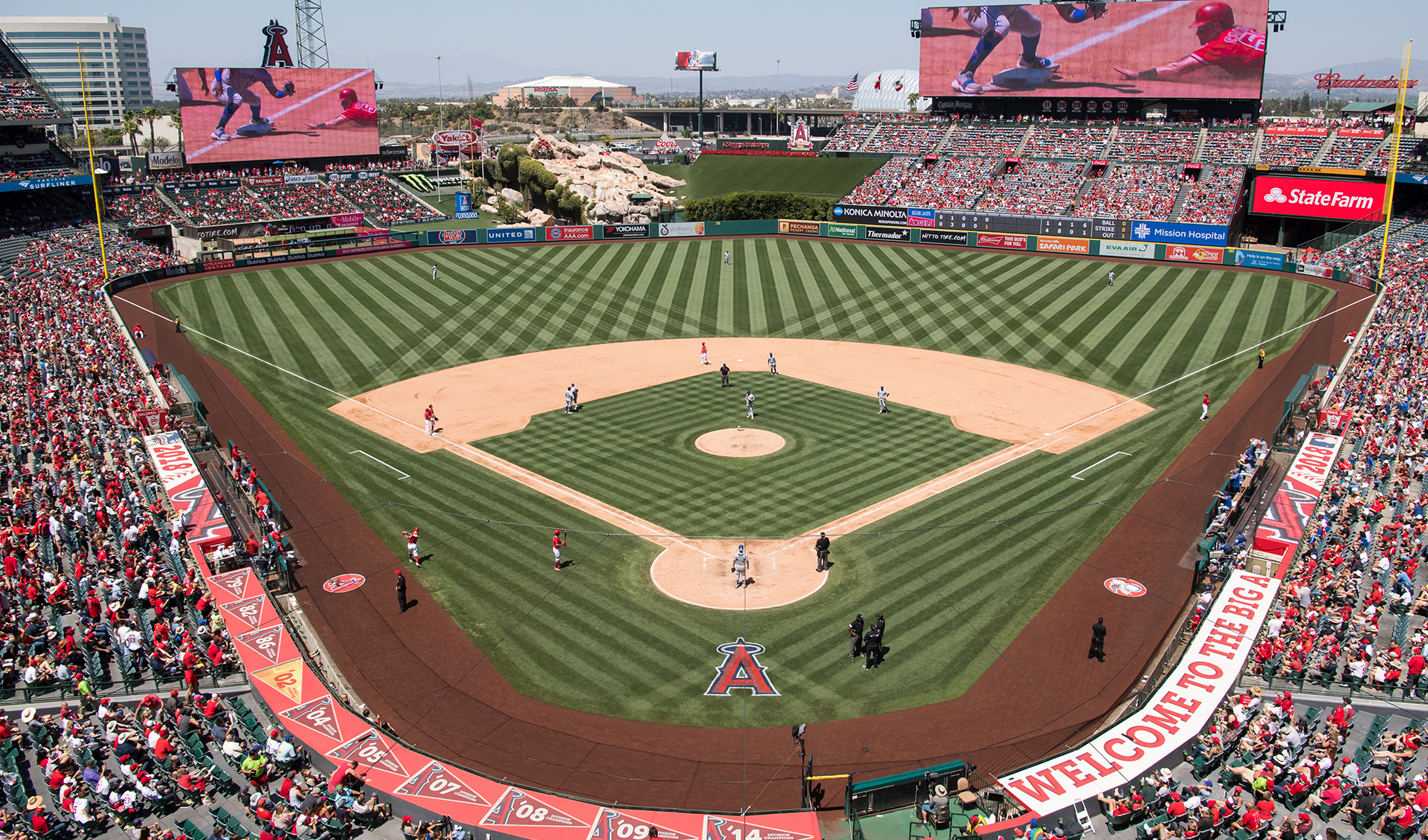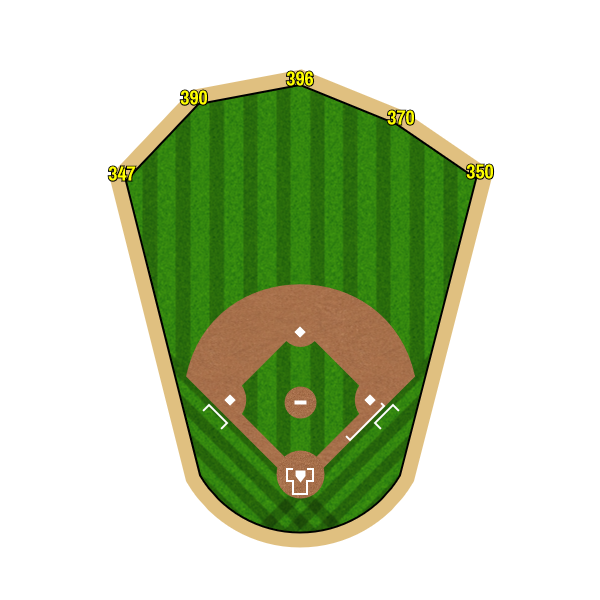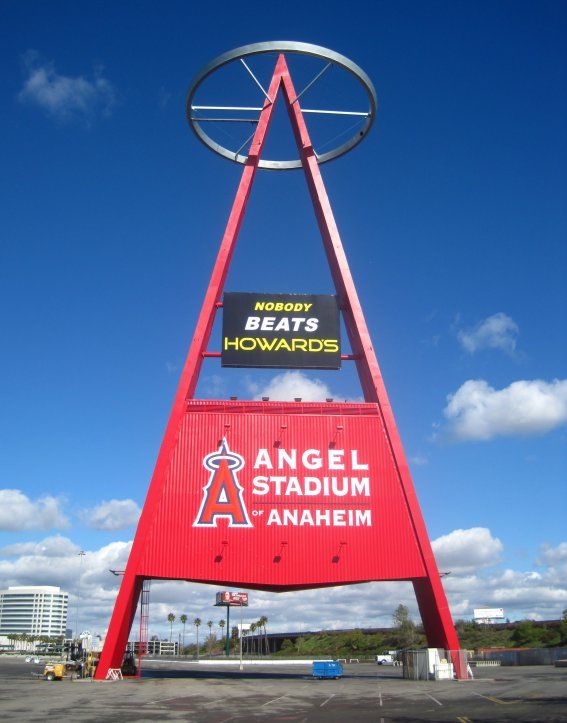Angel Stadium of Anaheim, CA, is the fourth oldest active MLB stadium. Home to California’s first MLB franchise the Los Angeles Angels, the ballpark has acquired its present state-of-the-art incarnation following periodical revamps. The baseball stadium’s design exhibits a unique blend of 1960s efficiency and 1990s retro-modern style. Angel Stadium began as a baseball-only facility before turning multipurpose in the 1980s and finally, returned to its neo-traditional form in 1997.
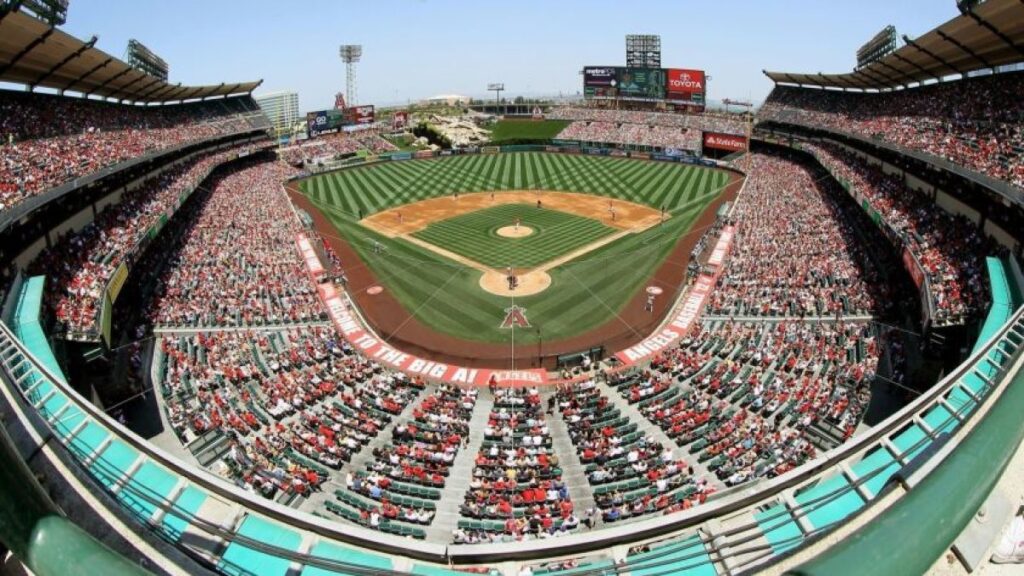
The History
The Los Angeles Angels played the inaugural 1961 season at Wrigley Field though the Los Angeles Memorial Coliseum was their first choice. Next season, the Angels had to play at Dodger Stadium and led the AL table most of the season before finishing third. Bo Belinsky stopped the Orioles 5-0 in the first no-hit game at the stadium. The Angels had fantastic 1963 and 1964 seasons too and their pitcher Dean Chance won the Major League Cy Young Award.
The team performance enlarged the fanbase calling for a dedicated home ground. It was hastened due to difficult terms proposed by the Dodgers’ owner Walter O’Malley for allowing the Angels to play there. Desperate for a new stadium, the Angels’ owners even contemplated relocating to the city of Long Beach. The MLB franchise finally found favor with Anaheim in Orange County and started building a ballpark on a 160-acre site in 1964.
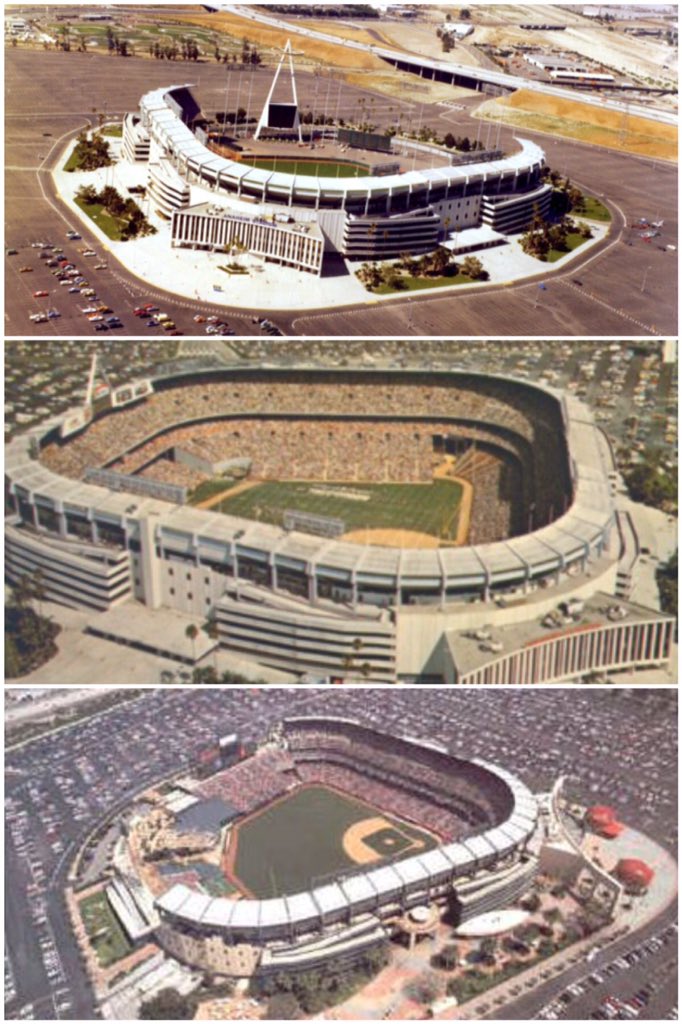
Angel Stadium was inaugurated on April 6, 1966, with the San Francisco Giants beating the home team. The Angels suffered another defeat when they played the first MLB game against the Chicago White Sox on April 19, 1966. Their first victory came the next day only.
Angel Stadium was first known as Anaheim Stadium. It got the nickname the “Big A” from the giant A structure overlooking the stadium. This was originally placed in 1966 to hold the scoreboard but was later moved to the parking lot. In 1998, Edison International bought the naming rights making it Edison International Field until 2004. Following the exit of the sponsor, it was renamed Angel Stadium.
Design and Features
The field at Angel Stadium was drawn based on a scientific study on the local air density during the afternoon and night. It was less than the standard MLB field length to neutralize any swing benefits to pitcher or hitter due to local weather conditions. Though field dimensions changed over time, still Angel Stadium at 396 feet has the third shorted center field in the MLB. Petco Park and Dodger Stadium at 391 feet and 395 feet respectively only fall short of the home ground of the Los Angeles Angels.
When the NFL franchise the Los Angeles Rams chose to ditch the Los Angeles Memorial Coliseum and move to Angel Stadium, the ballpark underwent renovation in the late 1970s. Modifications completed in 1980 included enlarged mezzanine and upper decks and elevated bank of bleachers to have 23,000 more seats during football games. This also changed the look of the baseball stadium into a trapezoidal, completely enclosed one obstructing the view of mountains.
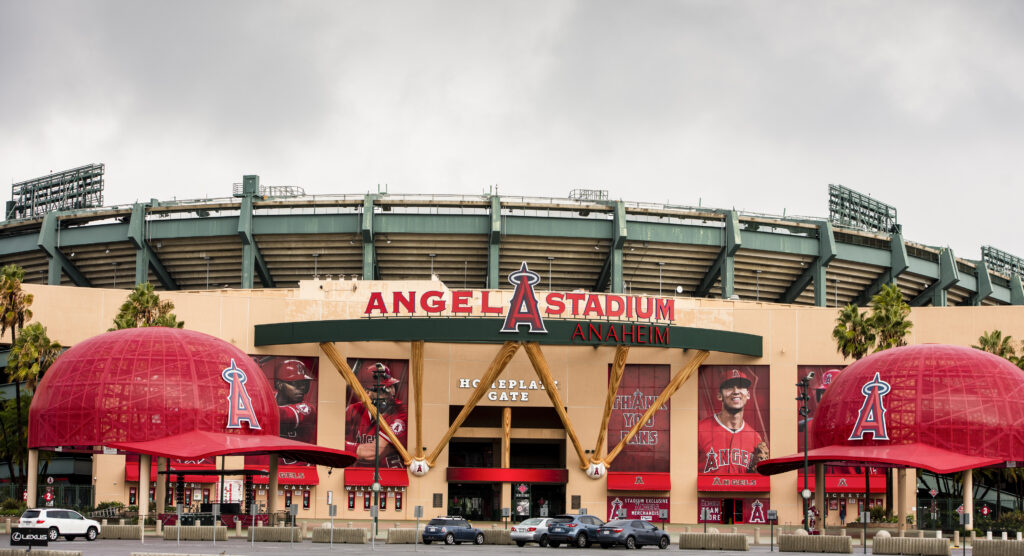
The Big A scoreboard holder was transferred 400 meters away to the parking lot and began to hold electronic marquee advertising. However, the Rams left Angel Stadium at the end of the 1994 season after a 14-year stint, and this ended its multipurpose use.
The 1999 Renovations
An earthquake on January 17, 1994, damaged the upper deck and scoreboard structure of Angel Stadium. The section was rebuilt and the collapsed Sony Jumbotron was replaced. When Walt Disney took over the Los Angeles Angels franchise in 1996, the ballpark underwent $118-million renovations until 1999 focused on giving an open feeling. Modifications converted Angel Stadium into a baseball-only facility. The section facing the outfield completely changed allowing a thrilling view of the San Gabriel and the Santa Ana Mountains.
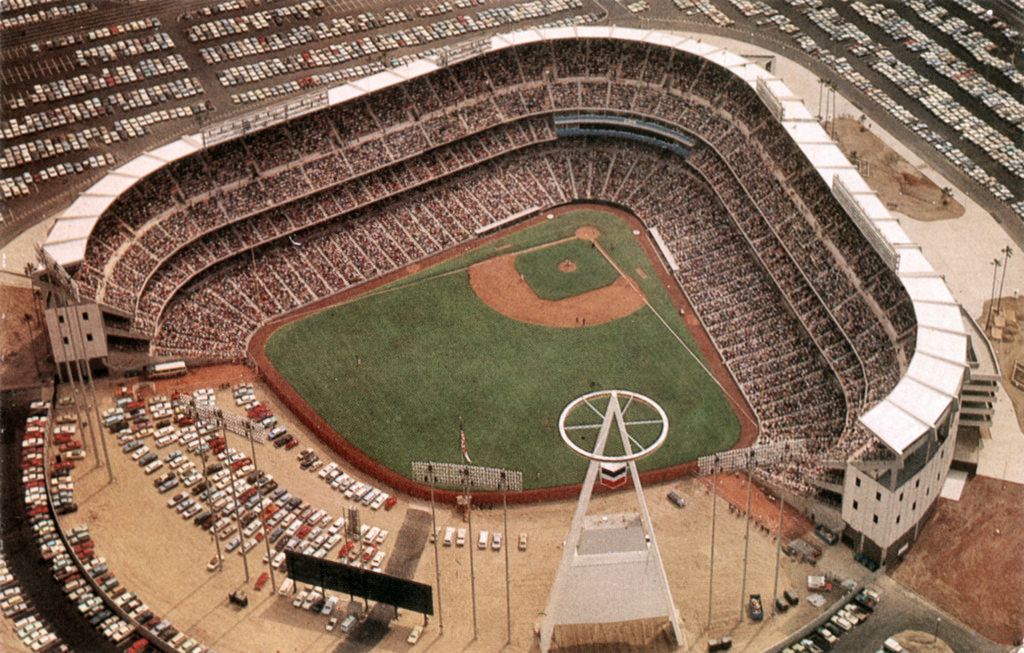
A new display board, outfield bleacher pavilions, and scoreboards were added while a new exterior came into existence. All seats turned green and the entire structure became an interesting mix of green and sandstone. The renovation made Angel Stadium’s field asymmetrical. It doubled the height of the right-center field fence and added a plaza next to the stadium perimeter. The 2017 season saw the installation of a 5,488 sq ft video display on the left field and another 9,500 sq ft, the fourth largest in the MLB, on the right field. It also witnessed the upgradation of the out-of-town scoreboard at Angel Stadium.
The California Spectacular
The 1999 renovation unveiled an amazing artificial panorama on display overlooking the left-center field. Like a Disney set, it has cascading streams emanating from hills and erupting geysers. Real trees on the rock give it a distinct original topography despite the man-made structure. Angel Stadium also has an exotic display of fireworks just before a game starts, when the Angels score a homer, and after every home win.
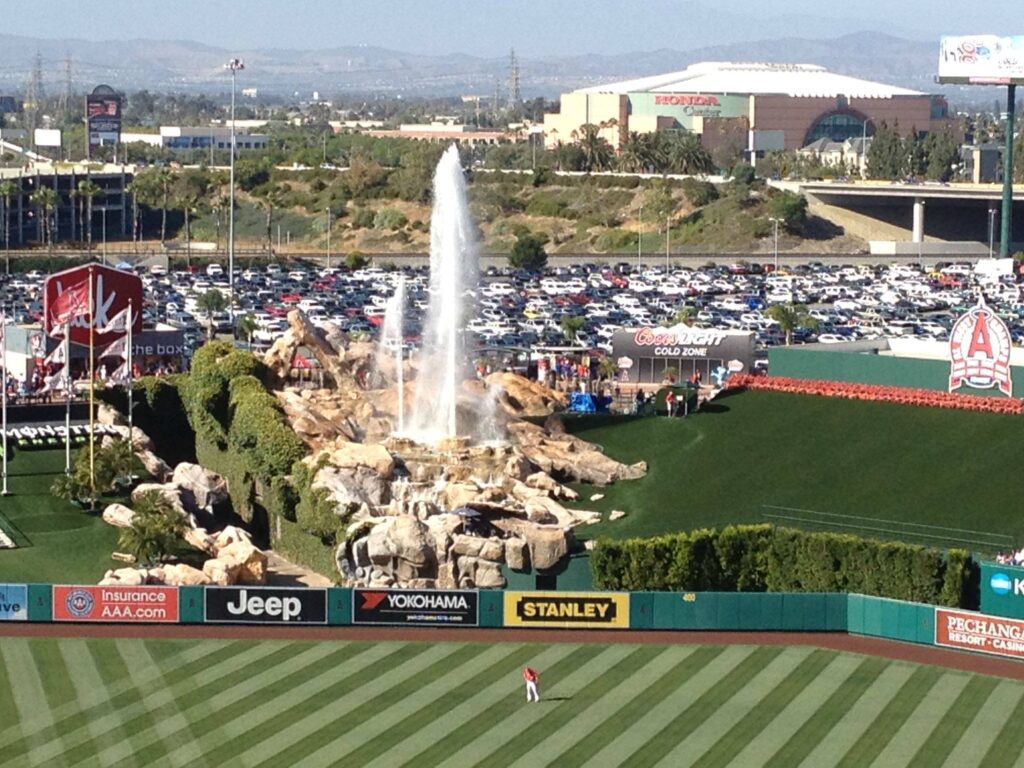
Facilities
Angel Stadium has five concession zones at the field, club, terrace, outfield, and view levels. Each zone has multiple eateries, bars, and merchandise stores. Both field and terrace levels have a dozen of dining places each. The Main Team Store at the field level boasts the largest collection of Angels apparel while the nearby New Era Store is well known for its customized hat embroidery. Visitors can buy “throwback” Angel merchandise from the Hall of Fame Team Store located at the terrace level.
The baseball stadium also has 5,075 club seats and 78 suites.
Purely Baseball Things To Know
- Built in 1966, Angels Stadium is the oldest active ballpark to host MLB games after Fenway Park (1912), Wrigley Stadium (1914), and Dodger Stadium (1962).
- Field dimensions were prepared after a scientific study investigating the air density during the evenings. This helped make the venue favorable neither to hitters nor to pitchers.
- In the inaugural match, the San Francisco Giants beat the Angels 9-3 before a home crowd of 40,735. Pitcher Jorge Rubio went for five runs before he was able to get one out.
- Angels’ pitcher Nolan Ryan, who is in the MLB Hall of Fame, achieved two no-hitters at Angel Stadium. Ryan had seven no-hitters to his credit.
- The Angels lost their first MLB game at the ballpark 3-1 to the Chicago White Sox on April 19, 1966.
- The home team won the first game on April 20, 1966, beating the White Sox 4-3.
- Angel Stadium was the venue for the 1967, 1989, and 2010 MLB All-Star Games.
- The ballpark hosted AL Championship and Division Series regularly since 1979.
- The home team won the 2002 World Series routing the San Francisco Giants.
- Mickey Mantle scored his last game-winning homer while Reggie Jackson and Albert Pujol made their 500th and 600th home runs respectively at Angel Stadium.
- The Angels played their longest ever home game against the Giants on August 9, 2014. It went on for 19 innings before the Angels won 5-4.

Non-Baseball Events
- Football
Angel Stadium was home to the NFL franchise Los Angeles Rams between 1980 and 1994. However, the first football game at the baseball stadium dated back to the 1970s. It was the very place where Eric Dickerson made his NFL rushing record of 2,007 yards in a single season in 1984.
- Soccer
The baseball stadium was the venue for the 1996 CONCACAF Gold Cup.
- Olympics
It is the prospective venue for the baseball and softball competitions during the 2028 Los Angeles Summer Olympics.
- Concerts
Angel Stadium is a regular venue for concerts. Artists and bands who had their concerts at the ballpark over the years include Pink Floyd, Scorpions, Loverboy, Foreigner, Madonna, Bob Dylan, David Bowie, U2, Paul McCartney, and The Rolling Stones.
- Other Events
- 1980 Speedway World Championship qualifying.
- AMA Supercross Championship since 1976.
- Christian Harvest Crusades since 1990.

